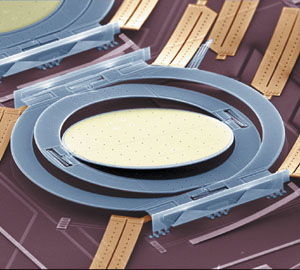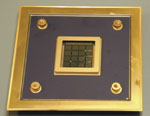Nanotechnology Consortium Looks Small to Reach Far
 |
| This microscopic mirror lies at the heart of many nanotechnology-driven devices. These mirrors can tilt in various directions to steer light to act as optical switches for information in the form of photons. |
The day may not be far off when microscopic machines embed a phone in an individual biological cell, decode a human genome or sniff scents with the acuity of the best-trained bloodhound.
These possibilities are nearing reality as scientists learn the art of manipulating matter on a nanoscale. So many potential uses are emerging that researchers often find themselves dealing more with economic limits than with theoretical ones.
In practical applications, scientists may be able to create organic semiconductors that would build electrical circuits with little more than an inkjet printer instead of a multibillion-dollar fabrication plant. In esoteric uses, microscopic adaptive optics might enable Earth-based astronomers to peer deeper into the universe than envisioned even with space-based observatories. Above all, the microscopic manipulation of matter promises spin-offs to a greater degree than previous technology introductions ever experienced.
Many potential nanotechnology applications are under development at the New Jersey Nanotechnology Consortium, which was founded by Lucent Technologies’ Bell Labs about three years ago. Based in
David Bishop, president of the consortium, relates that the National Science Foundation has estimated that nanotechnology will be a trillion-dollar-a-year industry within 15 years. Bishop, who also is the nanotechnology research vice president and the physical sciences research vice president at Lucent Technologies, explains that the consortium has an advantage over commercial facilities in that it has the flexibility to interact over a wide range of disciplines in this emerging technology.
The consortium has received a grant from the state of
The consortium is partnering with more than just
The consortium’s nanotechnology strategy encompasses four separate program goals. The first goal is to ensure that the consortium is first to market in current lines of business; the second is to use nanotechnology to create new lines of business in related areas; the third is to use nanotechnology to increase the amount of government business it does; and the fourth is to pursue advanced basic research into nanoscience. The consortium’s facility is designed to cover the entire spectrum of nanotechnology ranging from first research prototyping to high-volume manufacturing.
Bishop relates that the consortium has more than 60 customers as it focuses on a wide range of activities, including telecommunications, defense, homeland security, power, medical, health, environmental, chemical, biological and consumer product areas. These business arrangements may range from straight foundry work to technology development and even to product introduction. Devices, tools, processes, techniques and due diligence all fall under the nanotechnology center’s purview.
The consortium is organized internally by technology elements such as processing, test and measurement, networking, design, modeling and simulation, materials, and packaging. However, it divides its work by projects rather than by technology disciplines, as many projects are cross-disciplinary. Project managers head multidisciplinary teams and interface directly with customers.
“Nanotechnology is the place where physics, chemistry and biology intersect,” Bishop says. “It’s not pure physics anymore; it’s not pure chemistry anymore; it’s not pure biology anymore. It really is all of the above. Teams that make progress in nanotechnology are not single-disciplinary teams—they are strongly interdisciplinary.
“Nanotechnology is a kind of a scientific ‘perfect storm’ where these three areas intersect creating opportunity,” he analogizes.
Many U.S. Defense Department goals may be met by technologies under development at the consortium. The department’s transformational communications effort aims at bringing broadband access to the individual soldier, and nanotechnology will play a major role in that effort. “Nanotechnology is revolutionizing commercial communications, but the opportunity to revolutionize military communications is just as important,” Bishop states. “As we go forward with the transformational communications initiative, I think it essentially will be impossible to build it without nanotechnology.”
Researchers at the consortium are working on spatial light modulators for free-space optical communications that might be a cornerstone of this broadband access. The consortium is working to build sophisticated devices that manipulate both the phase and the direction of light on a bit-by-bit basis, Bishop notes.
This may enable rubber mirrors that permit free-space optical communications between satellites and terrestrial stations. These adaptive optics would both help laser tracking and adjust for atmospheric distortion that affects the laser beam’s bandwidth.
Other areas benefiting from spatial light modulator technology include ophthalmology and optical lithography, where engineers could replace photomasks for making integrated circuits with masks that could be programmed. This would allow development of integrated circuits in small numbers. Engineers could fabricate more sophisticated specialty chips without spending $10 million on a photomask.
Another side benefit of this research is that scientists would be able to conduct observational astronomy from the Earth that would rival anything that could be achieved from space.
The defense arena also can benefit from adaptive sensors based on nanotechnology. The consortium is working on liquid lens technologies that could lead to electronic corneas in which the curvature of the lens changes to follow images. The result could be low-cost liquid lenses that can focus on objects at different ranges. Unmanned aerial and underwater vehicles could be equipped with these lenses for tracking and surveillance in the same manner that the human eye can follow an object that moves across and throughout its field of vision. This liquid lens also could reduce jitter.
 |
| This 16 x 16 micromirror array was set in a 1,000-pin microelectromechanical device built by the New Jersey Nanotechnology Center. |
Bishop observes that diverse areas such as high-bandwidth radio frequency (RF) communications, smart acoustics, smart antennas, power sources and smart paints that change their properties all will benefit from nanotechnology advances.
The development of nanographs is allowing the creation of superhydrophobic surfaces so that researchers can tune how liquids interact with solids. These nanographs can help create novel batteries, heat sinks, optical devices and even chemical factories on a chip.
A range of sensor technologies may permit detection of substances at the one-particle-per-billion level or below. “Nanotechnology is going to create a very rich suite of sensor technology,” Bishop predicts. This includes sensors that can adapt to the environment. Some of these nanosensors are emerging in an effort known as the dog on a chip, which is building the equivalent of a dog’s olfactory abilities on a single chip.
Another canine characteristic plays a key role in information systems security. As RF handheld appliances begin to dominate the telecommunications arena, security becomes paramount. It may benefit from nanotechnology based on biologically inspired interfaces, Bishop notes. One goal would be to have a sophisticated human-machine interface that permits the machine to recognize and respond only to its owner in the same way that a dog knows its master and rejects a stranger.
Research into novel light sources focuses on tuning the properties of nanoparticles to create light sources over a wide range of spectra. These particles could be embedded in polymers to achieve nanoparticle fluorescence gains. This would create useful light for communications without the need for lasers.
Nanotechnology magnetometers under development in the consortium will allow detection of very weak magnetic fields. Deployed for perimeter sensing, these devices would be able to sense the magnetic field of a rifle from 500 feet away—or perhaps a submarine from tens of thousands of feet away, Bishop suggests. Mounted on ground vehicles, they could serve as the trigger mechanism for countermeasures against rocket-propelled grenades.
Several government-funded nanotechnology programs at the consortium aim at building a practical quantum computer. Studies have shown that quantum computing speeds could exceed those of classical computing by as much as 10 million times. Bishop believes that the goal of building a practical quantum computer that can perform some computational functions will be reached within a decade.
In the biological arena, consortium researchers are drawing from nature to develop materials with properties that mimic those of animals or other biological systems. A primary focus is to understand how nature creates nanopatterned materials that are stronger and lighter than anything invented by humans.
For direct biological applications, scientists are working to build devices for real-time DNA analysis. Bishop relates that research already has determined that the four base pairs of DNA have slightly different conductivity, so that measuring a DNA molecule’s resistivity is possible. A single strand of DNA would be pulled through a nanometer-size hole in a silicon wafer for its resistivity to be measured by nanosize electrodes.
This technique ultimately might be capable of decoding a human genome. Using the nanoelectrodes might permit decoding the entire genome in one hour for roughly $1,000, as opposed to $10 million and 100,000 person-years using conventional methods. The nanotechnology approach may permit each individual to have a map of his or her own human genome. It also could speed up the discovery of customized disease cures.
Bishop describes this DNA nanotechnology research as challenging but with a high reward for success. “You’re talking about taking an individual molecule and putting an ohmmeter on it and measuring it as we drag it past the leads on the ohmmeter,” he says. “That represents pretty cutting-edge stuff—manipulating things at the molecular level.”
Another biological program, in this case funded by the Defense Advanced Research Projects Agency, or DARPA, aims to develop a true cell phone. This device would be a microscopic RF transmitter that could fit inside of a living cell and transmit information to an exterior receiver. This phone could provide vital diagnostic information in the least possible invasive form.
Despite the difficulties inherent in blue-sky basic research, the primary challenge in nanotechnology remains manufacturing issues, Bishop claims. Keeping manufacturing costs down will be a major determinant in whether a nanodevice reaches widespread use. “If it takes a $400 million clean room [to build it], then ultimately it never will be a low-cost commercial device,” Bishop says.
“Biological organisms are examples of exquisite nanoscale engineering,” he continues. “We eat food, and it all goes together in some amazing way without anybody inside saying, ‘That calcium molecule goes over there; that sodium molecule goes over there.’ We know that it is possible to have a self-assembly where you can do exquisite nanoscale engineering and everything automatically goes where it is supposed to go. We don’t exactly know how to do that yet.”
The consortium’s nanoscale sensing research has turned up some interesting discoveries. Bishop relates that more than 50 years ago a nanoscale force known as the Casimir force was predicted to arise because of fluctuations in the electromagnetic spectrum at the nanoscale. Consortium researchers have discovered that this force, which is not observed between atoms or between macroscale objects, can be measured with nanoscale devices. In effect, these fluctuations cause nanometer-size plates placed nanometer distances apart to attract each other.
Facility scientists have had to design experiments to avoid this unusual nanoscale force, Bishop continues. For example, consortium scientists, along with partners in academia, are building nanoscale devices to measure gravity on short length scales. These devices may help resolve theoretical speculation on whether the functional form for gravity at 1 micron is different from the functional form for gravity at 1 kilometer. But to answer this question, the researchers must build these devices to nullify the Casimir effect.
“You get this nanoscale attractive force between nanoscale objects because a vacuum really isn’t full of nothing,” Bishop reports. “That’s kind of a mind-blower.”
Web Resources
Lucent Technologies
Nanotechnology Q&A With David Bishop: www.bell-labs.com/news/2004/january/bishop.html
National Science Foundation (NSF) National Nanotechnology Initiative: www.nsf.gov/crssprgm/nano
NSF Nanotechnology Fact Sheet: www.nsf.gov/news/news_summ.jsp?cntn_id=100602




Comments